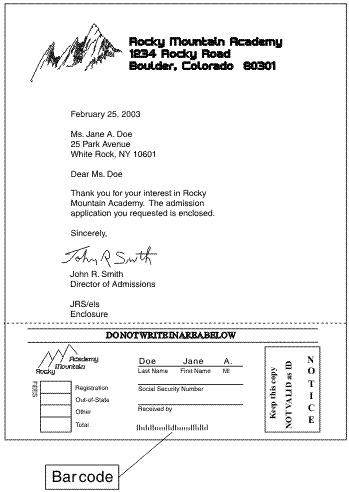 PSF for z/OS: User's Guide
PSF for z/OS: User's Guide
 PSF for z/OS: User's Guide
PSF for z/OS: User's Guide
|
Previous topic |
Next topic |
Contents |
Index |
Contact z/OS |
Library |
PDF
Bar codes PSF for z/OS: User's Guide S550-0435-04 |
|
Bar codesA bar code resource (or BCOCA resource) is a Bar Code Object Content Architecture (BCOCA) object stored as a resource in the page segment library. Bar codes are soft resources. Bar codes represent characters by sets of parallel bars of differing thickness and separation, multiple rows of parallel bars, or a matrix of data cells that is typically composed of squares or circles. These codes can represent, for example, product numbers, part numbers, and manual numbers. Bar codes can be read optically by transverse scanning. Figure 17 shows the bar code printed on the sample page. Figure 17. Bar codes on the sample page
 Many different kinds of bar code coding arrangements, or symbologies, are developed for specific applications. PSF supports both linear symbologies and two-dimensional symbologies. Some of these codes are:
Note:
To see if a printer supports bar code
encodings, such as Data Matrix, GS1 DataBar, Royal Mail RED TAG, and
USPS Intelligent Mail Container, use the display printer information
function in PSF. See &apsd000t; for
more information. A bar code can be created several different ways, but if it is created by using a set of MO:DCA-P structured fields called a BCOCA object, the object can then be stored as a resource for easier use. 


|
 Copyright IBM Corporation 1990, 2014 Copyright IBM Corporation 1990, 2014 |